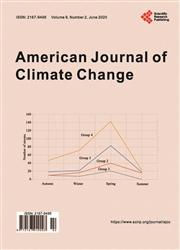Assessing the Correlation between Forest Degradation and Climate Variability in the Oluwa Forest Reserve, Ondo State, Nigeria
引用次数: 3
Abstract
Between 1981 and 1994, Nigeria lost 3.7 million hectares of its forests. It is estimated that less than 4% of Nigeria’s rainforest cover is left. Reckless use and abuse of the forest reserves in Nigeria lead to degradation. However, the relationship between forest degradation and climate variability has not been clearly elucidated. This study assesses the trend of forest degradation between 1986, 2002 and 2014 in the study area and also examines the correlation between forest degradation and climate variability using temperature and rainfall parameters. Classification of Landsat images (TM 1986, ETM+ 2002, and OLI 2014) and change analysis using NDVI values of three-timed period were performed to observe forest degradation in the study area. NDVI values were calculated by combining bands 4 (near infrared) and 3 (visible red) for Landsat TM and ETM+ and bands 5 (near infrared) and 4 (visible red) for Landsat OLI using the spatial analysis extension in ArcGIS environment Linear regression statistical analysis was employed to determine the correlation between forest degradation and climate variability. The results show a fluctuation in the trend of forest degradation, while a positive correlation coefficient of 0.58 shows that there is a relationship between forest degradation and temperature and rainfall variability. The study concludes that though there is a positive correlation between forest degradation and climate variability in the study area, the relationship is weak and not strong enough to make generalizations.尼日利亚翁多州奥卢瓦森林保护区森林退化与气候变化之间的相关性评估
1981年至1994年期间,尼日利亚失去了370万公顷森林。据估计,尼日利亚的雨林覆盖率只剩下不到4%。在尼日利亚,不计后果地使用和滥用森林保护区导致森林退化。然而,森林退化与气候变率之间的关系尚未得到明确阐明。本研究评估了1986年、2002年和2014年研究区森林退化的趋势,并利用温度和降雨参数分析了森林退化与气候变率的相关性。利用TM 1986、ETM+ 2002和OLI 2014三期Landsat影像进行分类,利用NDVI值对研究区森林退化进行变化分析。利用ArcGIS环境空间分析扩展,结合Landsat TM和ETM+的4波段(近红外)和3波段(可见红色)以及Landsat OLI的5波段(近红外)和4波段(可见红色)计算NDVI值,采用线性回归统计分析确定森林退化与气候变率的相关性。结果表明,森林退化趋势呈波动趋势,其正相关系数为0.58,表明森林退化与温度和降雨变率之间存在一定的关系。研究认为,研究区森林退化与气候变率之间存在正相关关系,但这种关系较弱,不足以进行推广。
本文章由计算机程序翻译,如有差异,请以英文原文为准。
求助全文
约1分钟内获得全文
求助全文

 求助内容:
求助内容: 应助结果提醒方式:
应助结果提醒方式:


